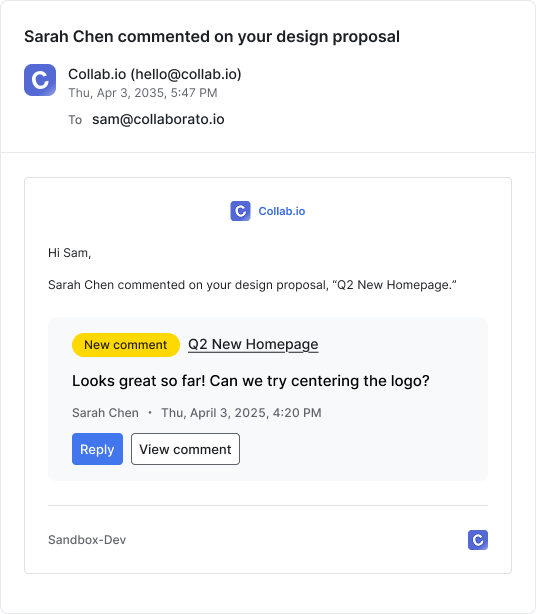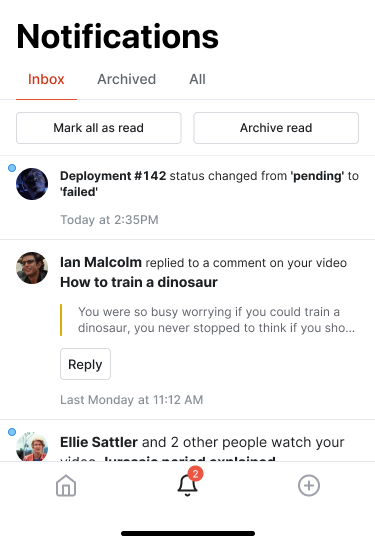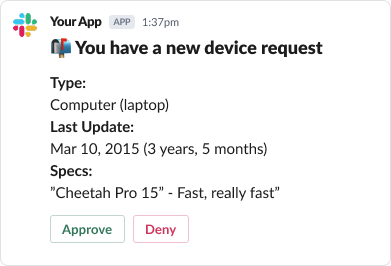Your notification system is only as good as the messages it delivers. Even the most sophisticated orchestration can't save poorly written copy that confuses users or convinces them to unsubscribe.
The right words, delivered at the right time, can drive product adoption and keep users engaged, so don’t take them for granted.
Whether you're sending your very first notifications or scaling them across multiple channels, this guide provides practical, channel-specific guidelines for writing notification messages that users actually want to read.
Notification copy best practices
Before diving into channel specifics, there are some general best practices to apply across every notification type regardless of the channel.
Be specific and actionable
Users scan notifications in seconds. Lead with the essential information and make the required action clear.
Instead of:
You have a new update in your account
[View update]
Write:
Sarah Chen commented on your design proposal
[Click here to reply]
[Click here to view project]
Include as much context as possible
Notifications pull users away from other tasks. Make the interruption worthwhile by providing enough context to help them decide whether to act immediately.
Instead of:
Your deployment’s status changed
Write:
Deployment #142 status changed from 'pending' to 'failed'
Use active voice
Active voice creates more engaging notifications by putting the actor first and reducing word count. It feels more personal and makes notifications easier to scan and act upon.
Instead of:
Your report has been viewed by 12 people
Write:
12 people viewed your report
Use consistent terminology
Match the language in your notifications to your product's UI. If your app calls them "projects," don't suddenly switch to "workspaces" in notifications.
Format differently for each channel
Every channel displays notifications differently, from character limits to link formatting and beyond. Make sure you know how your messages will appear across each channel before sending.
Writing guidelines by notification type
Transactional notifications
Transactional notifications confirm user actions or system events, so messaging clarity and accuracy matter most.
- Confirm exactly what happened
- Include relevant identifiers (order numbers, amounts)
- Provide next steps when applicable
- Maintain neutral, professional tone
Transactional notification examples:
Your order #4521 has shipped via FedEx. Track package: [link]
Password successfully updated. You'll need to sign in again on other devices.
Export complete: customer_data_2024_q4.csv (45.2 MB) ready for download
System notifications
System notifications communicate technical events or service status. Technical accuracy meets user-friendly language.
- Translate technical events into user impact
- Provide clear timelines when possible
- Offer actionable next steps
- Link to detailed information
System notification examples:
Scheduled maintenance tonight 2-4 AM EST. API responses may be slower than normal.
Your API key expires in 7 days. Generate a new key to prevent service interruption.
Storage usage at 85% (42.5 GB of 50 GB). Upgrade for uninterrupted service.
Lifecycle messaging
Lifecycle messages encourage users to return to your product. Balance value with frequency to avoid notification fatigue.
- Provide clear value proposition
- Use social proof when relevant
- Create urgency appropriately (not artificially)
- Respect user preferences
Lifecycle messaging examples:
3 teammates commented on your design. [See what they're saying]
Your weekly summary: 487 new visitors, 12% increase from last week
Lisa Chen completed the task you assigned: 'Update API documentation'
Promotional messaging
These messages typically communicate offers, updates, and new features with the goal of driving engagement and adoption.
- Lead with the benefit, not the feature
- Make offers specific and time-bound
- Include clear CTAs that match the message
- Segment based on user behavior and preferences
Promotional messaging examples:
Save 30% on annual plans — 3 days left to upgrade
New: AI-powered insights now analyze your team's productivity patterns
You've used 80% of your API calls. [Upgrade to Pro for unlimited access]
Channel-specific guidelines
Once you know how to write effective notification copy, it’s important to adhere to the different requirements of each messaging channel. The most effective copy in the world won’t mean anything if it gets unexpectedly truncated or meets a user in the wrong state of mind.
Below, get a birds-eye view of messaging best practices for each channel. These parameters will help you modify your messaging for reliable notifications on any channel you communicate with your users.
| Channel | Max Length / Characters | Structure | Tone | Images | Links |
|---|---|---|---|---|---|
| Subject: ~60 chars before truncation Body: No maximum limit, but keep it concise | Subject + Preheader + Greeting + Core Message + CTA + Signature | Professional, informative, personalized | Yes (but avoid large images and optimize for load time and mobile) | Yes (multiple links possible) | |
| SMS | 160 chars (hard limit for traditional SMS) | Clear CTA up front + optional context | Concise, direct, action-oriented | No | Yes (limit to one short link ideally) |
| In-App | Limit varies by UI, but ~60–80 chars per message | Short headline + body text + CTA button | Helpful, contextual, minimal | Yes (small icons or preview images allowed) | Yes (CTA buttons or inline links) |
| Push | iOS: ~178 total characters (4 lines) with title Android: ~65 characters for title, ~240 for body | Short hook + 1-line CTA | Urgent, clear, concise | No (some platforms allow small icons) | Yes (1 link max, usually via button) |
| Chat Apps (Slack, Teams) | No maximum limit, but keep it concise | Contextual header + brief message + optional button | Conversational, friendly, informative | Yes (thumbnails or previews in rich cards) | Yes (buttons or inline links depending on platform) |
Email notification guidelines

Email remains the workhorse of notification systems, offering the most flexibility for rich content and detailed information.
Due to its format, you’ll have to consider best practices for several different content formats, including subject lines, preview text, and body content.
Subject lines
- Maximum characters before truncation is ~60 characters
- Front-load the most important information
- Include specific details (names, numbers, items)
- Avoid common spam triggers (excessive caps, multiple exclamation points)
Subject line examples:
Invoice #4521 paid by Acme Corp
3 new candidates applied for Senior Engineer role
Your export of Q4 customer data is ready
Preview text
- Maximum characters before truncation is ~90 characters on desktop, ~35 on mobile
- Complement the subject line, don't repeat it
- Include actionable information or next steps
- Write complete thoughts that make sense even if truncated
Preview text examples:
Review their feedback and approve changes directly from this email
You have 24 hours left to claim your early bird discount. Register now
Sarah Chen and 2 others are waiting for your input on the roadmap
Email body content
- Greeting: Use the recipient's name when available
- Primary message: State the notification reason in the first sentence
- Context: Provide relevant details (but keep it scannable)
- Call-to-action: When action is required, make buttons/links obvious and descriptive
- Footer: Include unsubscribe and preference options
Email body content example:
Hi {{user.name}},
{{actor.name}} requested access to the {{resource.name}} dashboard.
**Request details:**
- Access level requested: Editor
- Reason: "Need to update Q4 metrics"
- Expires: 7 days from approval
[Approve Request] [Deny Request]
You can manage all pending requests in your [team settings].Push notification guidelines

Mobile push notifications face the strictest constraints but can drive immediate engagement when written well.
- Lead with the user benefit or required action
- Include specific details (names, amounts, items)
- Ensure the message makes sense without opening the app
- Adhere to character limits by device type
Mobile push character limits
It should be noted that character limits can vary based on device model, screen size, and user settings (like font size). The following limits for iOS and Android are conservative to ensure messages display properly across all phone models:
- iOS: 4 lines total, ~50 characters for title, ~175 for body
- Android: 7 lines total, ~65 characters for title, ~240 for body
Push notification examples:
Expense report approved
Sarah approved your expense report for $234.50
Your weekly report is ready
There was a 15% increase in conversions
Inventory alert
The Blue Widget stock is below your reorder point (12 units)
For more information on push notifications, read our blog, “How push notifications work on Apple and Android.”
SMS notification guidelines
SMS notifications demand extreme brevity while maintaining clarity, as they're often read on the go, and have little flexibility due to a lack of rich formatting options.
- Identify your service (if not obvious from sender)
- State the key information
- Include action if needed
- Always provide opt-out instructions for marketing messages
- Adhere to the 160 character limit*
Note: When an SMS message contains even a single character not supported by GSM7 (like an emoji), the entire message switches to UCS-2 encoding, reducing the character limit from 160 to 70.
SMS notification examples:
Knock: Your password reset code is 445-892. Valid for 10 minutes.
Payment of $125.00 received from ABC Corp for Invoice #4412. View details: [link]
Appointment reminder: Dr. Smith tomorrow (Jan 5) at 2:30 PM. Reply C to confirm.
In-app notification guidelines
In-app notifications appear within your product interface, typically as toast messages or in a notification feed.
What is a notification feed?

A notification feed is a persistent collection of notifications that users can access anytime through a dedicated interface element, such as a bell icon or sidebar. Unlike toasts, feed notifications remain available until explicitly marked as read or deleted, creating a historical record of important events and updates.
- Include timestamp (relative when recent: "2 hours ago")
- Support scanning with consistent structure
- Group related notifications when possible
- Mark read/unread states clearly
Notification feed item structure:
[Avatar] **Actor** action object
Supplementary details
[Timestamp] [Secondary action]Notification feed item examples:
Sarah Chen commented on your design proposal
"Love the new navigation approach!"
2 hours ago • View comment
Team Alpha completed sprint planning
15 story points across 8 tasks
Yesterday at 3:47 PM • View sprint
3 new applicants for Senior Engineer role
Marcus Liu and 2 others applied
Oct 23 • Review applications
For more information on notification feeds, read our blog, “The benefits of adding an activity feed to your B2B product.”
What is a toast notification?

A toast notification is a brief, temporary message that appears on screen to confirm an action or alert users to time-sensitive information. These notifications slide in from a corner or edge of the interface and disappear automatically or when dismissed.
- Limits vary by UI, but ~60-80 chars per message
- Single, clear message
- Avoid multiple actions
- Auto-dismiss after 5-7 seconds for non-critical messages
Toast notification examples:
"Settings saved successfully"
"Jason Lee started reviewing your pull request"
"Export complete: 2,847 records processed"
For more information on in-app messaging, read our blog, “Getting started with in-app messaging.”
Chat notification guidelines

Slack or Microsoft Teams notifications blend the richness of email with the immediacy of push. Use built-in formatting to improve scannability.
- Use
*bold*for emphasis - Include
@mentionswhen appropriate - Leverage emojis for visual scanning 🎯
- Use code blocks for technical information
- For Slack, create sections with Block Kit for complex messages
Chat examples:
Production Alert
CPU usage exceeded 90% on server api-prod-02
Current: 94% | Duration: 5 minutes
New customer signup!
Company: Acme Corporation
Plan: Enterprise ($499/month)
Users: 50 seats
The sales team has been notified. View full details in the customer dashboard.
For more information on chat app messaging, read our blog, “How to think about Slack and Teams as notification channels for your SaaS app.”
How to test your notification copy
Before shipping any notification:
- Read aloud: Does it sound natural?
- Remove context: Does it make sense without prior knowledge?
- Check truncation: Does the key message survive character limits?
- Test personalization: Do variables render correctly with real data?
- Verify links: Do all CTAs lead to the right place?
Implementation checklist
When implementing notifications in your product:
- Define clear categories (transactional, engagement, system)
- Create templates for common notification types
- Set up user preference controls
- Test across all target channels
- Monitor engagement metrics
- Implement batching for high-frequency events
- Plan for internationalization
- Document copy guidelines for your team
Start with templates
The fastest path to effective notifications is starting with proven templates. Here are starter templates for common use cases:
New user signup (Email):
Subject: {{actor.name}} joined your {{workspace.name}} workspace
Hi {{user.name}},
{{actor.name}} ({{actor.email}}) just joined your workspace as {{actor.role}}.
{{#if pending_approval}}
This user is pending approval. You can:
[Approve Access] [Deny Access]
{{else}}
They now have access to:
- {{list_of_permissions}}
{{/if}}
Manage team permissions anytime in [workspace settings].Payment received (SMS):
Payment confirmed: ${{amount}} from {{customer.name}} for Invoice #{{invoice.number}}. Balance: ${{remaining_balance}}Collaboration (In-app):
{{actor.name}} {{action}} {{object.type}} "{{object.name}}"
{{#if comment}}"{{comment}}"{{/if}}
{{timestamp}}Send effective, cross-channel notifications with Knock
Writing effective notifications requires balancing information density with clarity, urgency with respect for user attention. Start with these guidelines, but let your metrics guide refinement. Track open rates, click-through rates, and unsubscribe patterns to understand what resonates with your users.
The best notification is one that provides clear value at the moment users need it. When you nail that combination, notifications become a feature users love rather than tolerate.
Need to implement a notification system that handles all these channels? Explore how Knock can help you ship notifications in days, not months.